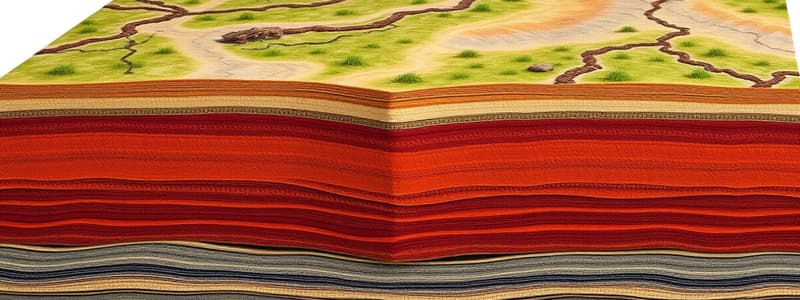Podcast
Questions and Answers
Which seismic waves are the fastest and first to be recorded during an earthquake?
Which seismic waves are the fastest and first to be recorded during an earthquake?
- Love Waves
- Secondary Waves
- Primary Waves (correct)
- Surface Waves
What is the characteristic of Secondary Waves that differentiates them from Primary Waves?
What is the characteristic of Secondary Waves that differentiates them from Primary Waves?
- They can travel through solids, liquids, and gases.
- They cause particles to move parallel to the wave propagation.
- They cannot travel through liquids. (correct)
- They travel faster than Primary Waves.
Which part of a seismic wave represents the maximum distance from the undisturbed surface to either the crest or trough?
Which part of a seismic wave represents the maximum distance from the undisturbed surface to either the crest or trough?
- Frequency
- Amplitude (correct)
- Period
- Wavelength
What type of waves are generated when the source of an earthquake is close to the Earth’s surface?
What type of waves are generated when the source of an earthquake is close to the Earth’s surface?
What best describes the motion of particles in Secondary Waves?
What best describes the motion of particles in Secondary Waves?
Which seismic wave type is known for causing the most damage during an earthquake?
Which seismic wave type is known for causing the most damage during an earthquake?
Which mathematician is associated with the development of the mathematical model for Love Waves?
Which mathematician is associated with the development of the mathematical model for Love Waves?
What describes the motion of Rayleigh Waves?
What describes the motion of Rayleigh Waves?
What is one significant importance of studying seismic waves?
What is one significant importance of studying seismic waves?
What characteristic of Rayleigh Waves can be observed in open spaces during an earthquake?
What characteristic of Rayleigh Waves can be observed in open spaces during an earthquake?
Flashcards are hidden until you start studying
Study Notes
Earth's Interior Layers
- The Earth consists of three primary layers: Crust, Mantle, and Core.
- The Core is divided into the Outer Core and Inner Core.
Seismic Waves
- Energy waves generated by earthquakes or earth vibrations, traveling through or along the Earth's surface.
- Seismologists use seismographs to measure the travel time of seismic waves across Earth's layers.
- Variations in Earth's density and stiffness cause seismic waves to refract (bend) or reflect.
Wave Characteristics
- Crest: The highest point of a wave.
- Trough: The lowest point of a wave.
- Amplitude: The distance from the undisturbed surface to the crest or trough.
- Wavelength: The distance over which a wave repeats, typically measured from crest to crest.
- Wave Height: The vertical distance from crest to trough.
- Period: Time taken for a wave to pass a fixed point.
- Frequency: The number of waves that pass a unit in time.
Types of Seismic Waves
-
Body Waves: Travel through Earth's inner layers.
- Primary Waves (P-waves): Travel fastest through all states of matter (solids, liquids, gases), recorded first during earthquakes.
- Secondary Waves (S-waves): Slower than P-waves, can only move through solids, causing rocks to move up/down or side-to-side.
-
Surface Waves: Travel along the Earth's surface after body waves and are typically more destructive.
- Love Waves: Named after Augustus Edward Hugh Love, travel faster than Rayleigh waves, move ground in a side-to-side motion, causing significant damage.
- Rayleigh Waves: Named after John William Strutt, travel as ripples like water surface waves, observable in open spaces during earthquakes.
Importance of Studying Seismic Waves
- Understanding wave behavior in different materials helps seismologists deduce Earth layer composition.
- Assists in locating and analyzing fault lines along with the stresses and strains they undergo.
Studying That Suits You
Use AI to generate personalized quizzes and flashcards to suit your learning preferences.




